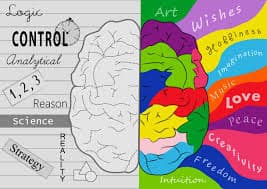What is Attention-Deficit/Hyperactivity Disorder?
Attention-deficit/hyperactivity disorder (ADHD) is a brain disorder marked by an ongoing pattern of inattention and/or hyperactivity-impulsivity that interferes with functioning or development.
Since the right hemisphere of the brain regulates impulsivity, attention, and socially appropriate behavior, a child with decreased right brain activity may be hyperactive, oppositional, disruptive, and even aggressive.
Source: The National Institute of Mental Health:
Inattention
Inattention means a person wanders off task, lacks persistence, has difficulty sustaining focus and may be disorganized. These problems are not due to defiance or lack of comprehension.
Hyperactivity
Hyperactivity means a person seems to move about constantly (including in situations in which it is not appropriate), excessively fidgets, taps, or talks. In adults, this may be reflected by extreme restlessness or wearing others out with constant activity.
Impulsivity
Impulsivity means a person makes hasty decisions/actions that occur in the moment without first thinking about them (which may have a high potential for harm) or a desire for immediate rewards or inability to delay gratification.
An impulsive person may be socially intrusive and excessively interrupt others or make important decisions without considering the long-term consequences.
Print out the FAQs about ADD/ADHD!
Digging Deeper into Attention-Deficit/Hyperactivity Disorder
As many of you know, there is a right and left side of your brain. Each side of your brain has a unique set of tasks that it is responsible for.

The right side of the brain controls impulsivity, attention, and socially appropriate behavior. A child with decreased right brain activity may be hyperactive, oppositional, disruptive, and even aggressive.
The Question becomes: How Can We Help the Brain?
Roger Sperry won the 1981 Nobel Prize in Physiology and Medicine for his work with split-brain research. Much of his early research was in the differences between the right vs left brain. The way we understand the brain today is largely because of his research. Sperry would later give us an incredible insight into how Chiropractic can have a profound impact on those with ADD/ADHD.
“90% of the stimulation and nutrition to the brain is generated by the movement of the spine”
The brain is powered by the movement of the spine?
Each and every bone (vertebrae) in your spine has multiple nerves that exit between it and the bone above and below it. These nerves travel to every muscle, cell, tissue and organ in your body.
It is a constant cycle between the brain sending signals to the body and the body sending signals to the brain, both tasks are completed via these nerves.
The bones of the spine were designed to move in very particular ways depending on their location in the spine. They were also designed to protect the nerves underneath them no matter what movement is taking place.
The movement of the spine stimulates these nerves which send constant signals to the brain. The brain uses those signals to make constant changes to the body and adapting to the environment.
Read more about the impact of the nervous system on your body.
If these signals are limited or reduced, then the brain does not receive the necessary stimulation. Over time, this can create a weakness or imbalance.
How does this relate to ADHD?
- The brain is stimulated by spinal movement.
- If the spine is not moving the way that it should, there will be a decrease in stimulation.
- Over a period of time, this will produce an imbalance/weakness in brain activity.
- Neurological based chiropractic looks for the ares of the spine causing the imbalance/weakness.
- When the weakness is removed, the body can stabilize the brain activity naturally without the need for lifelong drugs.
Find research and additional tools on pediatric chiro.
Ready to get started? Schedule your first appointment here.